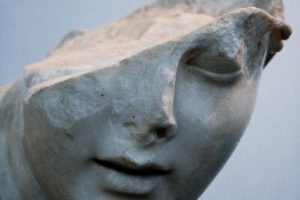Infinity in a Grain of Sand: Part II – Universal Principle of [Aham] I Am
by Igor Kufayev
So we spoke about that uncertainty of the I, that is there at all times, and seems to refuse to go. How can we ever be sure at what point exactly we are no longer this so-called “small self” and we are, without a shadow of a doubt, the Self. Is there a pathway, or some kind of gateway? A border? How do we know that we passed through? Where is there a threshold? Is there a threshold? Is there a place which we literally transgress? Where we move beyond and, again without a shadow of a doubt, we know that this is indeed who I am, and everything that I thought prior to that of myself is nothing other than a figment of my own projection? And the finitude of that is incomprehensible aspect of my magnitude, which shines forth in myriads of forms and phenomena? Where do we draw the line? Can we ever draw the line? Is there a place where we have that certainty?

Why to speak about this at all? Well, to begin with, there are perspectives today in and among the spiritual preceptors, where the sentiment or incentive is expressed that as long as the I remains, one is a bound soul. So the I itself is not something that has been universally agreed upon.
I have heard this in spiritual circles when this has been repeated, very often drawing its references back to such well-established figures as Ramana Maharshi. Somehow this line of thought has entered — this perspective that as long as the I remains in one’s experience, then that is not it. It’s only the dissolution of the I that amounts for the true deal. And it hits squarely back to what we have spoken about yesterday. If you remember, I wanted that to be very emphatic because it’s a very important affair. The reassurance on my part was then, “you cannot ever have anything where the I would not be the centrality of experience,” which is a very different perspective, isn’t it? Very different perspective.
I would like to simply open this into the field of your own inquiry — into the field of your own investigation — whether there is indeed any possibility for having any experience where the I will fall away, as it is often spoken about. It’s spoken from the most dry intellectual approaches to almost poetic allusions to how that I falls away. And yet, there is another perspective. This perspective is upheld by the very kernel of the teachings known as Kashmir Shaivism. This perspective is what makes Kashmir Shaivism stand as a unique philosophy, where that centrality of I is spoken of in terms of that aham. Aham — I am. And it interestingly enough resonates profoundly with that same Biblical “I am”. It’s not “I am so-and-so.” It’s not even “I am God.” Simply “I am.”
There are these so-called “great sayings,” — mahavakyas. Perhaps the most well-known one is Aham Brahmasmi. Literally, “I am totality.” Or “I am absolute.” Aham Brahmasmi. No more, no less. Another one: tat vam asi. You may have heard that. Tat vam asi. “Thou art that.” A more poetic translation. Or more direct: “I am that.” Ayam atma brahma. Another one. Ayam atma brahma. Ayam atma brahma. It could be translated as “This soul is absolute.” Atma: soul. Brahma: absolute.
These sayings were formulated not just for philosophical purposes to dust the libraries. They were meant to be alive and used by folks as ourselves. They’re meant to be used as a daily reminder of who I am as opposed to a myriad of other things I can suddenly identify myself as, on account of Awareness essentially having that knack. It just can be anything it wants to be! And that’s the amazing thing about it. Anything that comes after that aham, immediately that’s what it is. So this is what makes it so profound, complex, and simple at the same time.
So when we go back to these perspectives exalted through the teachings of Kashmir Shaivism and its illustrious sages, that aham — that “I am” — is the universal principle. It’s that trinity. That equilateral upon which everything rests, which is in fact everything. It’s the alpha and omega of Tantric philosophy. Say it aloud: Aham. Aaaaaaaaaaaah. It’s the vowel that stands for Shiva. The sound has no end. It’s infinite. A vowel never ends; it cannot end, because it’s an open sound. And it represents the power inherent in Shiva, which becomes ha. Ha. We often hear this at the immersions. People in meditation spontaneously exclaim that. Ha — it’s that expression that stands for Shakti.
So imagine this equilateral triangle. At the top is the sound of Ah. Ha in one of its lower corners. And then that what is known as idam: the sound which grounds it in the humming reverberation of that emmmmmm, which is basically all there is — it’s the whole entire creation. This is what we have now, you see? Aham. Aham is pure awareness, what Shiva stands for; ha as the power of that awareness to manifest into anything. It’s the power of the absolute, exemplified by Shakti. And that final em is the matrix of creation. That emmmmmm is that reverberating sound where potentiality finally collapses into form. This emmmm is that what everything is, what we behold, whether we look at a flower or whether we look into the hubble telescope and view the trillion of galaxies upon trillion of galaxies.

So this aham — this “I am” — is forever rooted in that ah. In that “I”. “I am”. “I am”. Even in the English “I am” you can trace that same thing. “Ayyy am”. Ayam. “I” stands here for that pillar of light — funnily enough, even in the way it is graphically represented as a letter — the column, the verticality of Shiva. And “am” here is that what is the whole of creation. Energy and mass — everything. This is revealed in the most direct manner, in the depth of the most profound nirvikalpa samadhi, where there is no awareness of any sensory, mental, or somatic perception whatsoever — there is nothing, even the faintest traces of space and time are dissolved. One abides in that purity of one’s self as I. Am. And that I cannot go anywhere. Because if someone says that it can fall away, then there would have to be a verification of that experience. But in order for someone to verify that, one needs to come back and with certitude say that I was without an I. Ha!
So it’s a simple inference. What’s required is a simple analysis of that. Even to testify that the I fell away, I would have to testify it. We are indebted to those sages who spoke and wrote about it with tremendous clarity. We stand on their shoulders. And we speak about it with that same audacity simply because this is our — or I should say my experience. Because in this case it’s never our experience. It’s only experience that belongs to the I.
Why do we speak about it, and make these waves, and have that mode of delivery, why have such import through the sound in the voice? What is the big deal about it? What is so important about this? Well, because this is tremendously practical. It is tremendously practical in terms of what we are faced with when understanding of the limitation of whom we consider ourselves to be. Because as long as there is this nagging sensation of that part of me that needs to fall away, then the battle is elsewhere. The energy goes elsewhere. It’s like we’re locking horns with the wrong guy. We’re having an argument with ourself. That portion needs to be freed with this clear understanding. The ego can be looked at with precision as what it represents: the universal quality responsible for individuation. Propped with this understanding, we can see that there is nowhere we can locate that I. That I is unlocatable. Unlocatable precisely because it’s like arguing how the aperture of our diaphragm can open to what we consider as our experience. Whatever is the limitation of that diaphragm, that is our identity at the moment of that experience. So in other words, this is a confirmation that the ego itself is not a fixed identity. And if one is equipped with this perspective — with this philosophical proposition — then one can see, providing one carefully examines their own experience, that it’s this fluctuating membrane. And we are experiencing it. We know exactly when that fluctuation is a gripping sensation of isolation. When that fluctuating membrane contracts to that state of separation. And we also know when that membrane opens up and embraces and makes us one with the experience. When that happens, we feel ourselves simply “unravelled across the universe”, as the poetess has said. That feeling of being unravelled across the universe is that. It’s the diaphragm opened to embrace it all.
So infinite experience can be tapped into and we indeed do tap into it, often without really acknowledging, without realizing that that infinity is here at the tip of our fingers very often. In fact what this whole thing is about is to be able to taste the infinity, even through the sensory apertures. Even through what is often considered to be a limitation — what’s often considered to be the very concealing powers which rob us of that experience of infinite Self. This is, if you will, the noble perspective of Tantric philosophy.
This is why in circles where Tantra is understood, there is never an attempt to bypass or to ignore the physicality of our existence. Because that is contrary to what is actually happening. This is precisely where one can forego the very purpose of this incarnation. This is precisely where one can literally miss the whole thing. Miss what is really happening, in hopes of some greater happening, if you will.
With that being said, we will not ignore the fact that there is indeed the world of gross reality and refined reality; Tantra does not just lump it all into one heap. And there is indeed a danger of being engrossed by worldly affairs. Our consciousness can literally succumb to this gross experience of reality, unless it is opened and seen through the purified windows of perception. So in other words, the work aims at returning to the world through the cleared windows of perception. One consciously enters this process so that one can find one’s way back into the world to enjoy in much greater measure what this world is, stands for, and has to offer.
So going back to that infinite versus finite. By now this should give you a glimpse into whether there’s any line that can be drawn. Because one may still be under the impression, “so when do I know that this is no longer my finite self, and now I’m suddenly enjoying the glory of infinite?” Where is the line? Do you feel where the line is? Do you feel how blurred that line is? Do you see now how utterly impossible it is even to draw that line? It’s whatever that aham is. Or whatever goes after that aham that colors that I. Whatever that frequency; whatever that reverberation. And of course, it’s wonderful to get lost in that reverberation. And that’s what we do. Until we recover ourselves to the source of that frequency.

But other than that, that “where am I ended as finite being, and where am I infinite,” it is on each of us to discover that. Dive in and find out through your experience. Come out into the field of sensory experience, and notice. And see where you begin and where you end. Can you draw the line? Do you know? Where you begin and where you end? This is an invitation to work with what you represent in full measure always, in all ways.
Question: So what work is there to do, between the finite and the infinite?
The question may come to the surface, is there any work, then? Is there any place left on the part of the one who is clearly both the infinite and the finite. Is there anything left to do? Or is understanding this all it takes? And this is a very important question, because that philosophy contains an invitation. But if that invitation is accepted without understanding what this really means, then we settle for a concept of reality and may again bypass an opportunity that is present in this lifetime to bring this to cognition. Somewhere, in some mental department, maybe there was this “aha!” moment. Temporarily things were more lit. Somehow there was this clearer idea that, “wow, I never thought of that! That all there is is this I. And ‘am’ defines me, and whatever comes after, really, is just a matter of identification, and if I can just figure that out, then I am unbounded.” In principle, that is the case. But what is our day-to-day experience? That’s what matters. So therefore, just by expounding on that perspective — the doctrine of the centrality of the I, where the definition of ego is an elusive category—we also are immediately in danger of bypassing the real work, and creating a possibility where we’ll be exempt from any effort on our part. This is why we include this addendum, so that we can have something else to have in mind and to ponder on.
So to gain clarity on this, we must bring that sense of individuality back into the picture. It is an elusive thing, that which is defined by boundaries. That sense of individuality is defined by boundaries of identity. When we speak from the perspective of these perennial traditions, individuality — this personality — is defined by the boundaries of identity. And these boundaries can be a personal confinement, a decent-sized property and anything else you can imagine. One can live in a palace of these self-created boundaries. Therefore, it’s not easy to have that sense of discrimination present at all times. And it is that sense of discrimination that is required from every sincere spiritual aspirant. Because without that discrimination one simple settles on something. And if one settles on a set of ideas or ideology, then there will be easily a propensity to remain in the status quo.
One way or the other, when we speak of this idea of what it means to be an individual, it’s a cultural phenomenon anyway. It is defined by a set of certain ideological confinements we could call a consensus reality. Once a certain consensus reality is shared, the notion of individual comes forth in the way it is defined by that particular society; by that particular culture; by that particular civilization. Therefore even when we come to acknowledgement and recognition of who are we, in terms of our individual set up, we already are up against the culturally set mold. We are already, as it were, measuring ourselves against what is out there being perceived by ourselves and in turn projected outward because that ape-like mimicking is very strong in us human beings. We like to feel special. And yet, with that sense of specialness, there is always a very strong sense of conformity. This sense of conformity, to conform to a certain ideology — how it manifests itself in the idea of what the individual represents.
So this conformity is very much part of where that mimicking is. Whether we like it or not, this is always in motion, as it were. It’s always at work. And if you have ever examined a life of an extraordinary being — extraordinary in any way, in any degree, not just in the world of spirituality. Anyone who was credited with some kind of breakthrough. Whether we speak of Mahatma Ghandi or Lalla of Kashmir, whether we speak of Albert Einstein or Charlie Chaplin, we will find that these people had one shared trait: utter disdain and disregard for that what is meant to keep one firmly bound in this ideological perspective. There was this refusal to be molded.
This analogy here is relevant to any seeker in as much as we are trying to get to the bottom of what identity represents. Because if we are to speak of what it takes to be a fully developed human being, then we should speak of having a being fully in possession of cosmic consciousness; nothing less would do. So in other words, already here is a very different set of where we want to aim. The idea that the human being somehow breaks through or has some way to express themselves in life, and spirituality comes as this appendix or some kind of an addition to help along the line of success story, is a very naive, new-age idea. Naive and also bankrupt at its essence.Because it fails to redress the most important thing. It keeps adding, bandaging. Keeps adding to the existent bandwagon of these applicational methodologies so as to keep intact the rotten idea of who a healthy individual being is considered to be. But healthy individual being in an unhealthy culture is a phenomenon I’ve never heard of. So the whole thing needs to be turned upside down. We understand what it means to be a proper individual, or full individual, or fully developed individual, or simply speaking, fully a human being, that means someone who uses this God-given gift: the birthright, equipped with this marvel of the nervous system, which affords this being to experience itself as cosmic being. So the cosmic consciousness here is spoken of in terms of the basis of personality.

So there is no other basis of personality we could speak of. Everything would essentially be a discombobulated idea that we try to adjust, and this is what the modern field of psychology is doing. It forgets to answer a very straightforward question — or maybe forgot even to ask that question: can we even trust the notion of what it means to be a healthy human being? A healthy, well-developed individual. What does that mean? What is this individual like? These are the questions. And these questions are pertinent to how we are to work with that finite self, so that the infinite self shines through in all conditions and circumstances.
So this is just that addition to the Kashmir Shaivist understanding of the infinite and finite, and the centrality of the I in all experience. The “atman is brahman” — the soul is the absolute — we can settle, we can cherish this understanding, we can cherish this idea. But where is our work? Where is the part that can assist that process for it to be actualized? The question can only come with this greater understanding that what we call individuality or personality is a cultural phenomenon — a set of ideas that have been accepted and became something that we adhere to, we aspire to, and we have role models out there to aspire to. But we have no idea if that person reached any heights of their inner development. Hence the gap between the inner and the outer keeps growing. The ideas about success are so widespread that we then learn that our heroes are very often depressed people. Those whom we put our trust and projections, likes, are not even fully developed individuals when we speak in terms of what it truly represents.
So this is a very important reminder, so that we don’t settle on this lofty concept and discard the possibility of where our work is still due. That there is still the inner and the outer, and the outer development can never — again, never ever replace the inner one. This is the other way around. It’s like putting the cart before the horse.
In the development of the full potential here is inseparable from the melting of these boundaries, and these boundaries are of two kinds. The outer — they are always, of course, very subtle, but they are the outer boundaries, the boundaries of the societal way of how things are. But in this post-post-modern age, we can kind of find our way, because there are so many niches, so many different levels and layers, and everything is kind of accepted. So one can be this, one can be that; one can find one’s niche and coexist quite perfectly in all that.
But what’s more important is this melting of the boundaries that are of internal dimension. And these boundaries of internal dimension are precisely what defines our personality and how we think about ourselves — whom we consider ourselves to be. Because there are these two aspects: one is how we project ourselves outward and how we would like to be perceived; and the other is how are we being perceived by ourselves. That’s where the truth lies. And in the age of the digital revolution, it’s the most perfect conditions for that alternative ego development. We develop it out there completely, and build it up and invest in that, and it’s very possible because there are apps for that. Why don’t we even call them “ego-propping apps”. Like instead of having Facebook, you just call it that. That would be more honest and direct. A lot is invested here; we want to keep that and prop it up, so there is a very clear definition of how we are being perceived.

The thing is, from the perspective of this understanding that comes from age-tried, timeless, time-tested wisdom traditions, this is of no consequence for our development. The way we are perceived is of no consequence. So in other words it’s a pure bubble. It’s a pure bubble if there ever was one, in terms of how it reflects our inner development. Because in the words of His Holiness Maharishi Mahesh Yogi, “We are never in terms of others; others are always in terms of ourselves.” The world is defined from within outwardly, not the other way around. It is how we are that defines the world. The world out there cannot define us. It’s simply impossible. And this is where the true work really begins. The work of transcendence and the work of the melting of these boundaries.
These boundaries are made of psychic conditioning. If we speak of boundaries, there has to be something that acts as a boundary. If we create a wall — like there was a wall across Europe called the Berlin Wall. It had to be a proper wall; not a wall you can hop over. It had to be a wall that defines the different social structures. On this side of the wall is one social structure, on the other side is another, so the wall had to be very tall, made of bricks. It’s an extreme example. The fence may be defining the parameters of some territory we consider to be mine. In the same way, the parameters that define our sense of identity are made of something. And they are made of that psychic repository. They are made of these vasanas — these stresses, or psychic impressions. So therefore true spiritual work is impossible without melting down these boundaries, the melting down of these stresses, dissolving these stresses. This is part of all traditions where energetic transformation is the bread and butter.
– Igor Kufayev, adapted from the discourses at the immersion in Ojai, CA, December 2018. Edited, Mexico, January 2019.
